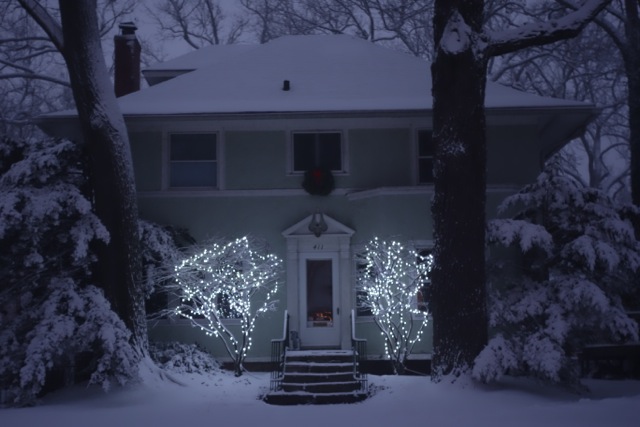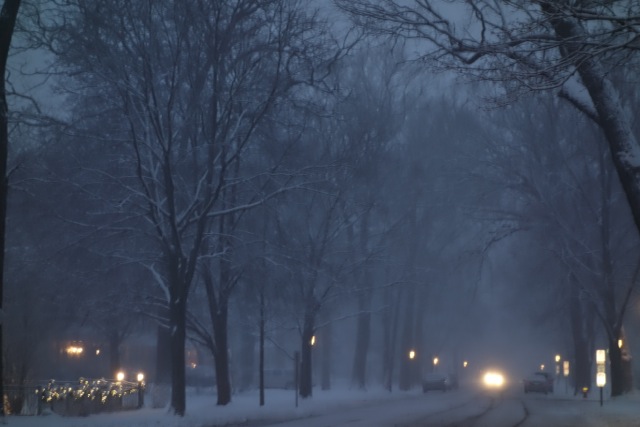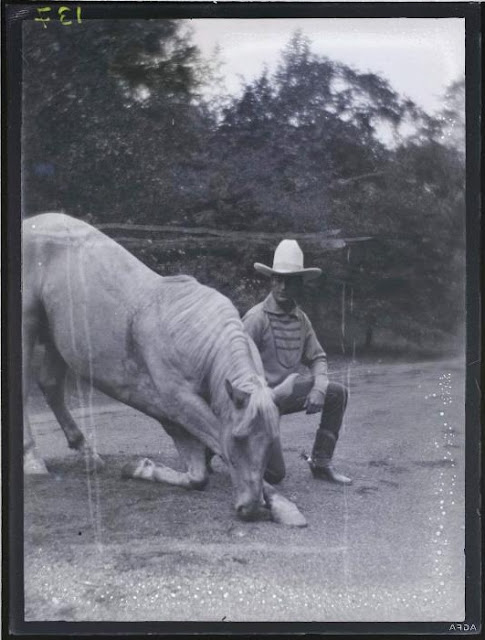Monday, December 31, 2012
Another World
How rarely any real winter weather appears on this rolling screen. The weather seems grueling and noteworthy on the northern coast of California when the sky is merely dark and there is maybe some rain and wind. It never gets any worse than that, not even at the midwinter moment called New Year's Eve. Vistas like the ones above (tall avenues of barren trees, flat white expanses of actual freezing-cold snow, mystical frosty twinklings) never come this way unless, like now, they are sent across the continent by a friend with an expressive camera, visiting urban Midwestern scenes.
Lilies
I went over to the East Bay to stow the Christmas tree in the garage for another year (the same tree Mabel helped decorate earlier in December, as seen below on her mother's phone). After the tree was gone and the furniture redistributed, it was possible to try out the new Christmas pottery vase from my daughter using some early blooming lilies from the garden.
Sunday, December 30, 2012
After-Christmas Toy-Time
I came and stayed with Mabel Watson Payne on Saturday afternoon and evening while her parents went out. There were no Christmas toys scattered about the place. All the news toys and games and puzzles and art supplies had found homes and had been put away.
But after her parents left, it was Mabel's great desire to get everything out and empty all the neatly labeled boxes and coat the entire living room floor with jigsaw pieces and little animals and pretend cooking utensils and dress-up props. Once sufficient chaos was created, we played with just about everything, but in cycles – as determined by some system known only to Mabel herself.
At one point she got independently interested in the magnetic fishing game below. I happen to know this is not even a new toy. It is an old toy. But its appeal enjoyed a leap anyway.
Munkácsi
"In his day, the Hungarian Martin Munkácsi (1896-1963) was one of the most famous photographers in the world. His dynamic photographs of sports, entertainers, politics, and street life in Germany and Hungary from the late 1920s and 1930s, were taken in a new, freewheeling style that captured the speed and movement of the modern era. Many of those early photographs were published in German photo weeklies, where Munkácsi made his reputation doing reportage, often from exotic locales. In 1933, Munkácsi turned his energetic style to fashion photography, making images of models running on the beach. Those pictures revolutionized fashion photography with their informality and vitality. Soon after he was offered a contract by Carmel Snow, the editor of Harper's Bazaar, and he left for New York, where he made his fame and fortune." – International Center of Photography
1. Parachutes, Munich, 1928
2. Swimming Instructor, Berlin, 1928
3. Steamship Bremen, 1929
4. Landscape Painter, Berlin, 1930
5. Athlete (with stocking garters), Germany, 1930
6. Eva Szaplone in Rumble Seat, 1932
7. Daisy & Violet Hilton, Birmingham, 1932
8. Dog Market, England, 1932
9. Frida Kahlo & Diego Rivera, Mexico, 1933
10. Frida Kahlo on Bridge, 1933
11. Buck the Fairy-Tale Horse, New York, 1934
12. Wrestlers, New York, 1934
13. Doris Duke, Honolulu, 1939
14. Peignoir, New York, 1936
15. Dior, New York, 1949
Decapitation
At the beginning of his photographics career, still stuck in obscurity in Budapest, Martin Munkácsi (1896-1963) made these documentary photographs revealing the mechanism behind the stage magic of chopping off a man's head. Chopping off a man's head was never in the repertoire of any magic shows I ever saw or heard of at any point during my mid-20th century American childhood (where sawing the lady in half was the standard equivalent). Perhaps the vaudeville circuits of Eastern Eruope in the 1920s offered many such theatrical thrills never exported to the squeamish west.
Glass Negatives
 |
| Ballet Students |
 |
| Couple on Bench |
 |
| Blocking the Curtain |
 |
| Dancer |
 |
| Dancers Rehearsing |
 |
| Trampoline |
 |
| Wrestler |
 |
| Tea Time |
 |
| Men With Penguin |
 |
| Man With Monkey |
 |
| Men With Sea Lion |
 |
| Two Men |
A "lost" archive of glass negatives appeared on E-Bay in 2007. They had been made early in the career of Hungarian innovator Martin Munkácsi (1896-1963). The International Center of Photography in New York acquired the collection and has digitized the negatives. They are now viewable alongside many of Munkácsi's vintage prints, mostly dating back to the late 1920s and early 30s. In a few cases, newly-made prints of the previously unknown negatives are also displayed. But the negatives on their own exert an enormous authority.
Back in 2006 Steidl published a striking book (still in print) of Munkácsi's photographs. The small surviving amount of fame he can claim these days rests on the crisp, dramatic, spontaneous-yet-technically-polished black-and-white compositions featured in the Steidl book, but virtually its entire contents come from a later period than the work shown here.
Subscribe to:
Comments (Atom)











































